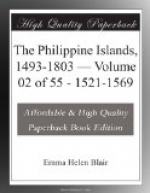The Spanish settlement on Cebu was regarded with great jealousy by the Portuguese established in the Moluccas, and they sent an armed expedition (1568) to break it up. As the two nations were at peace, the Portuguese commander and Legazpi did not at once engage in war, but carried on protracted negotiations—a detailed account of which is here presented, from the official notarial records kept by Legazpi’s chief notary, and transmitted to the home government. Legazpi claims that he has come to make new discoveries for his king, to propagate the Christian religion, and to ransom Christians held captive by the heathen in these regions; and that he had regarded the Philippines as being within the jurisdiction of Spain. If he has been mistaken, he will depart from the islands at once, if Pereira will provide him with two ships. The latter refuses to accept Legazpi’s excuses, and makes vigorous complaints against the encroachments of the Spaniards. Pereira summons all the Spaniards to depart from the islands, promising to transport them to India, and offering them all aid and kindness, if they will accede to this demand; but Legazpi declines these proposals, and adroitly fences with the Portuguese commander. These documents are of great interest, as showing the legal and diplomatic formalities current in international difficulties of this sort.
The Editors
Documents of 1525-1528
Expedition of Garcia de Loaisa 1525-26 Voyage of Alvaro de Saavedra 1527-28
[Resume of contemporaneous documents, 1522-37]
Translated and synopsized by James A. Robertson, from Navarrete’s Col. de viages, tomo v, appendix, pp. 193-486.
Expedition of Garcia de Loaisa 1525-26
[These documents are all contained in Navarrete’s Col. de viages, tomo v, being part of the appendix of that volume (pp. 193-439). They are here summarized in even briefer form than were the documents concerning the voyage of Magalhaes, indicating sources rather than attempting a full presentation of the subject. Navarrete precedes these documents with an account of Loaisa’s voyage covering one hundred and ninety pages—compiled, as was his account of Magalhaes, from early authors and the documents in the appendix.]
A memorandum without date or signature [2] describes to the king the advantages that would arise from establishing the India House of Trade at Corunna rather than at Seville: the harbor of Corunna is more commodious; it is nearer the resorts of trade for the northern nations; much trade now going to Portugal will come to Corunna; larger ships can be used and better cargoes carried; it is nearer to sources of supply, and expeditions can be fitted out better from this place; and it will be impossible for the captains or others to take forbidden merchandise, or to land articles on the return voyage—as they could do at Seville, because of having to navigate on the river. (No. i, pp. 193-195.)




